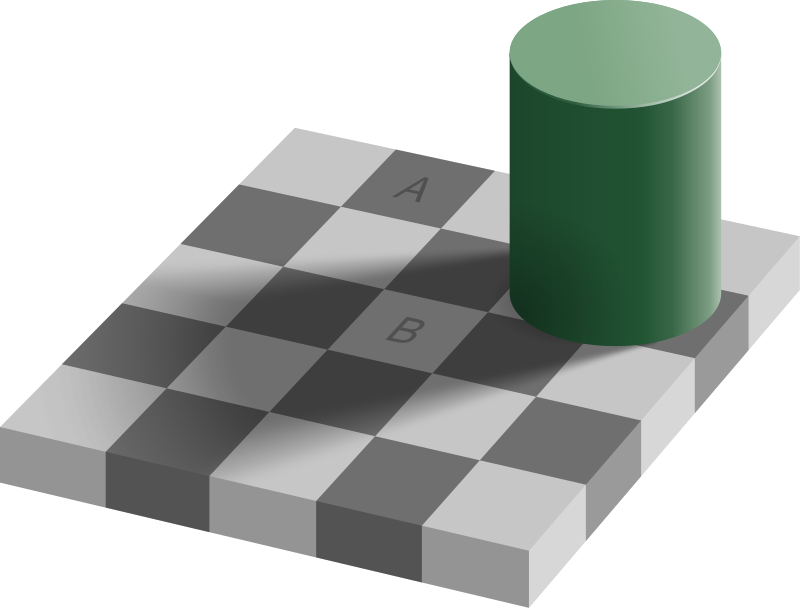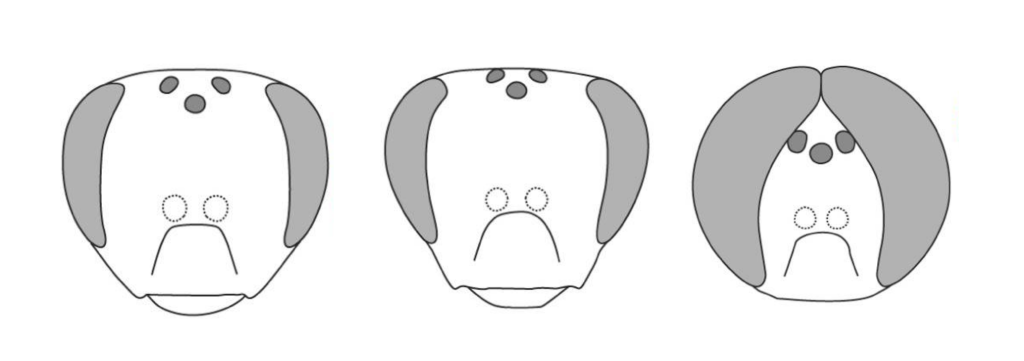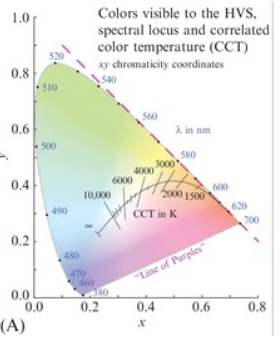Honey bees have five eyes but can’t see the color red.
In addition to two large compound eyes, the Western honey bee, Apis mellifera, has three simple eyes called ocelli located on the top of the head for female bees and on the front of the head for drones (male bees).1 The purpose of the ocelli, which can do little more than respond to the presence of light, puzzled scientists for a long time, but a 2017 study found that the information ocelli collect is used for color constancy, the visual processing that helps us to determine the color of objects whether they’re in shadow or sunlight.2

Color constancy is difficult enough for humans, so the fact that honey bees figured out such a simple solution is fascinating. The authors of the study commented “Evolution has invested millions of years finding clever solutions to practical tasks in life. Understanding how insects solve these tasks is important, because it can give us hints around ways to avoid using complicated solutions that require sophisticated, energy-hungry computers.”4
Bee’s color vision is shifted along the electromagnetic spectrum in comparison to humans, so their color vision extends into the ultraviolet but is unable to pick up on the red shades humans can see so easily. Like humans (who have photoreceptors for red, green, and blue) bees have three different types of photoreceptors as well — green, blue, and ultraviolet.5 With trichromatic vision, all colors perceived by the brain are necessarily made out of a mixture of those three colors. Since color perception has more to do with physiology than the actual electromagnetic spectrum, this can lead to some oddities.

From left to right: worker bee, queen, and drone.6
For example, the colors of purple, magenta, and pink are non-spectral colors, which means that they aren’t associated with a single wavelength of light. The spectral colors, by contrast, include red, orange, yellow, green, blue, indigo, and violet. Instead, purple and magenta are the result of the simultaneous excitement of our red and blue cone cells.7
Despite purple being a common color for flowers, as it contrasts strongly with the green of leaves, since bees don’t have red photoreceptors, they wouldn’t be able to fully appreciate purple flowers in the same way we do. So, it is primarily the colors violet and blue — in addition to ultraviolet bullseye designs, often found on flowers that look a plain white to us — are what draws bees to pollinate flowers.8

Blue, however, is a color rarely seen in flowers. The color is difficult for plants to produce, so the few blue flowers that naturally exist are mostly found in harsh environments, like the Himalayan mountains, where pollinators are scarce and attracting bees is a larger priority.10 Still, the scarcity of blue flowers remains mysterious. A review of studies on plants in the southwestern Alps found that blue flowers were studied more than any color, and tulip growers have long been trying to breed a blue tulip, so far with little success.11
Selective breeding has resulted in tulips of every color except for a true blue.12 One tulip variety (Tulipa gesneriana cv. Murasakizuisho), which produced violet flowers with a small area of blue at the bottom due to a mutation affecting the transportation of iron ions, has been intensely studied for over a decade in hopes of one day being able to genetically engineer a completely blue tulip.13 So far, however, the breakthrough has yet to come.
There’s another kind of impossible tulip: the broken tulip. Once prevalent and highly prized for their beautiful colors, today only a handful of varieties exist, most in private conservatories.14 In the seventeenth century, tulip mania, the famous speculative bubble that led to frenzied tulip auctions beginning in the Netherlands before spreading to much of Europe, introduced the “broken tulip” to the world. Broken tulips, which had beautiful variegated patterns, were not the result of selective breeding but small scale biological warfare — tulips were infected with a virus to produce the desired coloration.15

At the time, the mechanism behind the broken tulip phenomenon was unclear, with many tulip growers attempting to break tulip bulbs by exposing them to harsh environmental conditions or even sprinkling paint of the desired color into the soil.17 Since there was no way to tell whether or not a given bulb was broken and tulip bulbs had to be purchased months in advance before delivery, this led to a wildly speculative market, with people purchasing tulip bulbs for large amounts of money in the hopes that the prices of tulips would keep going up and they would make a profit.18 The most expensive tulip ever sold was the Semper Augustus, which had red and white broken coloration.19 It was sold for 3,000 guilders, which is approximately 180 thousand US dollars today.20
However, it was understood, even at the time, that broken tulips were suffering from some sort of illness. Broken tulips were weaker, smaller, and produced offspring that struggled to thrive.21 Artists would be commissioned to paint portraits of particularly valuable tulips before they inevitably wilted, and working class people, who didn’t have the disposable income to sink into a highly unstable futures market, would purchase art of broken tulips instead of broken tulips themselves.22
For this reason, the vast majority of tulips today with a striped or flame-like coloration are not true broken tulips, but tulips that have been selectively bred in order to have a similar appearance.23 The few broken tulip varieties in existence seem to have benign variants of the disease that have little effect on the plant except for the signature coloration.24 Because broken tulips are outlawed in many places, including the Netherlands where they originated, the chances of any of us seeing a true broken tulip is very unlikely.25
But for bees, it’s red and purple tulips that are an impossibility.
NOTES
1 Streinzer, Martin et al. “Sex and caste-specific variation in compound eye morphology of five honeybee species.” PloS One vol. 8, no. 2, 2013.
2 Garcia, Jair E. et al. “Improved color constancy in honey bees enabled by parallel visual projections from dorsal ocelli.” PNAS vol. 114, no. 29, 2017, pp. 7,713 – 7,718.
3 Adelson, Edward H. “Checkershadow Illusion.” Perpetual Science Group @ MIT, http://persci.mit.edu/gallery/checkershadow.
4 Dyer, Adrian et al. “Want a better camera? Just copy bees and their extra light-sensing eyes.” The Conversation, 3 July 2017.
5 Avargues-Weber, Aurore et al. “New vistas on honey bee vision.” Apidologie vol. 43, no. 2, 2012.
6 Streinzer, Martin et al.
7 Dufaux, Frédéric et al. “Perceptual Design for High Dynamic Range Systems.” High Dynamic Range Video, Academic Press, 2016.
8 Avargues-Weber, Aurore et al.
9 Dufaux, Frédéric et al.
10 Dyer, Adrian. “The mystery of the blue flower: nature’s rare colour owes its existence to bee vision.” The Conversation, 24 January 2021.
11 Adamo, Martino et al. “Plant scientists’ research attention is skewed towards colourful, conspicuous and broadly distributed flowers.” Nature Plants, 2021.
12 Noda, Naonobu. “Recent advances in the research and development of blue flowers.” Breeding Science vol. 68, no. 1, 2018, pp. 79 – 87.
13 Shoji, Kazuaki et al. “Perianth Bottom-Specific Blue Color Development in Tulip cv. Murasakizuisho Requires Ferric Ions.” Plant and Cell Physiology vol. 48, no. 2, 2007, pp. 243 – 251.
14 Klein, JoAnna. “Broken Tulips: ‘That Last Gasp Before Death’.” The New York Times, 11 May 2017.
15 Lesnaw, Judith A. and Said A. Ghabrial. “Tulip Breaking: Past, Present, and Future.” Plant Disease vol. 84, no. 10, 2000, pp. 1,052 – 1,060.
16 Ibid.
17 “The Botanical Mystery That Fueled Tulipmania.” Amsterdam Tulip Museum, https://amsterdamtulipmuseum.com/topics/the-botanical-mystery-that-fueled-tulipmania/
18 Lesnaw, Judith A. and Said A. Ghabrial.
19 Ibid.
20 Osnabrugge, Willem van. “Money in the 17th century Netherlands.” van Osnabrugge Genealogy, 2016, http://vanosnabrugge.org/docs/dutchmoney.htm.
21 Lesnaw, Judith A. and Said A. Ghabrial.
22 Ibid.
23 Ibid.
24 Klein, JoAnna.
25 Ibid.